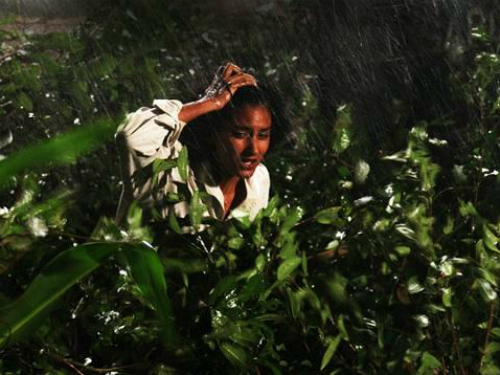
The tale of an Occidental merchant whose dreams of riches for his beloved daughter collapse under the weight of his own greed and prejudice.
EN
“A lush yet fragmented tale of colonialism, one could mistake it for the work of Claire Denis if not for the more hushed, deliberate camerawork (where Denis is sensual and loose, Akerman's rigor betrays her continued allegiance to alternative narrative forms). The film stars Stanislas Merhar (the fatal obsessive from La Captive) as Almayer, a Dutch trader long living in Malaysia whose attempts to control the (geographical and sexual) fate of his grown, mixed-race daughter, Nina, leads to his ultimate disillusionment and ruin. Of course it's far more complicated than that, but Akerman takes a pared-down approach that both simplifies and enriches what might have been a convoluted story. She calibrates her film delicately so that the focus feels more on Nina's escape rather than Almayer's decline, while at the same time granting Nina autonomy by freeing her from traditional narrative strictures; Akerman tells Conrad's story of Nina, but in the fashion of a reader skimming the pages, skipping about, stopping to focus intently on a particular detail then jumping off again. Akerman's personal, peculiar methods of storytelling leave Nina unknowable but never exoticized. She's in a dialogue with the filmmaker, not the subject of another's art. A colonialist casualty, she has struggled to find her identity. But like the greatest Akerman heroines, she owns her physicality.
There are myriad visual glories in this languorous film (its images of the deep, dark thickets of the Malaysian jungles are vivid and textured in ways that Gauguin could only dream of), but a pair of jaw-dropping long takes stand out, and they're the last two images. They are the resolution of Almayer and Nina's escalating conflicts, which are at once familial, racial, sexual, and geographical. The first, an incredibly complex shot takes us to the edge of a river, from where Nina and her lover Daïn plan to escape the meticulous choreography of the actors, the camera, and an approaching boat turns the sequence into an oddly affecting tango with nature, one with high emotional stakes. And then, we have a breakdown, unbroken: Almayer has lost everything, and Akerman, in a moment of simultaneous sympathy and punishment, trains the camera on Merhar's face as it all but dissolves for a remarkable amount of time. It's breathtaking in its concentrated pity.”
Michael Koresky and Jeff Reichert1
“Almayer's Folly can strike one as bleak and severe, and yet Akerman spoke of it as a film made in an atmosphere of total joy experienced by everybody involved. She relaxed her normally ultra-systematic, pre-planned style: both the actors and the camera were free to move within the basic parameters she set down. She evoked it as a rare occasion in which filmmaking and life fully interpenetrated, a time of laughing, singing, eating, dancing, and drinking. This is The Akerman Paradox: the intense sensuality of every kind of material (cinematic, gestural, natural, architectural, musical, social) is pressed into the service of exploring the most abominable outposts of supposedly civilized behaviour. Gaspard Almayer is the worst kind of blinkered racist that white culture could possibly produce, but he is also a father completely in love with his daughter – a passion which moved Akerman, and sparked in her the determination to begin the long haul required (four years) to get the movie made and released, against all odds.”
Cristina Álvarez López and Adrian Martin2
- 1Michael Koresky and Jeff Reichert, “In the Distance,” Reverse Shot, 10 August 2012.
- 2Cristina Álvarez López and Adrian Martin, “Video Essay. Before and Elsewhere: Chantal Akerman's “Almayer's Folly”,” MUBI Notebook, 26 October 2015.

